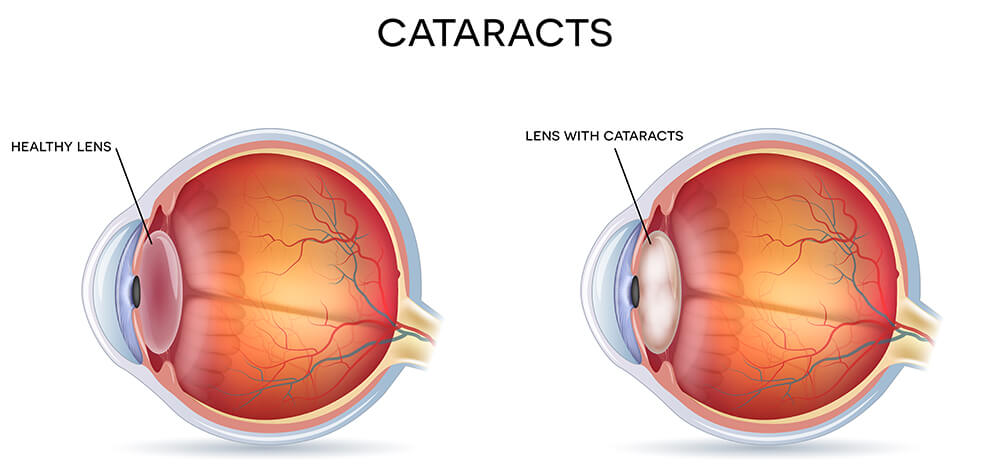What is a Cataract?
A cataract is the clouding of the eye’s naturally clear lens. The lens is part of the eye that helps focus light on the retina. The retina is a light-sensitive layer of tissue lining the inner surface of the eye. The optics of the eye create an image of the visual world on the retina through the cornea and lens. The clouding caused by a cataract reduces the sharpness of images reflected in the retina resulting in blurred vision.

Most cataracts are related to aging, usually starting at age 40. Cataracts are so common that by age 80 more than half of all Americans either have a cataract or have already had cataract surgery.
What Types of Cataracts are There?
There are three main types of cataracts:
- Cortical cataract
- Nuclear cataract
- Subscapular cataract
These aren’t the clearest to understand terms, so let’s try to break it down further. A cortical cataract occurs in the part of the lens surrounding the center of the lens. They are known for the white opacities that begin near the side of the lens, then move towards the center.
Nuclear cataracts, on the other hand, are typically connected to the aging process. They form deep in the nucleus of the lens.
Lastly, a subscapular cataract happens at the back of the lens. You have a higher chance of a subscapular cataract forming if you have diabetes or take high doses of steroid medications.
What Causes Cataracts?
As we know, cataracts form in the lens of the eye. This lens consists mostly of protein and water. In a healthy lens, the proteins stay out of the way, keeping the lens clear of obstruction and letting light pass through.
However, in some people, these proteins huddle together. This creates a cloudy formation in the lens. As this cloudiness grows, it can obscure vision, making things appear blurry.
While we understand under what conditions cataracts form, we know less about why these conditions occur. One common theory is that as we age, the oxidation level of the eye lens changes. The change in oxidation levels makes it easier for proteins to group, thus causing a cataract. This theory is backed by several studies showing that diets high in antioxidants, such as some fruits and vegetables, tend to prevent cataracts.
Beyond age, though, experts have come up with a list of risk factors that could act as causes of cataracts:
- Diabetes
- Exposure to ultraviolet radiation
- Hypertension
- Genetics
- Long-term use of some cholesterol medications
- Obesity
- Previous eye injury, inflammation, or surgery
- Smoking
What are the Symptoms of Cataracts?
Different types of cataracts can cause various symptoms. A subscapular cataract can develop with little or no symptoms until it’s fully grown. Nuclear cataracts, on the other hand, can improve near vision. This improvement is only short-term, though, and the common cataract symptoms will soon appear.
For instance, the first symptom you’ll experience is blurry vision. Many people describe the effect as if you were looking through foggy glass.
As your cataract continues to develop, you’ll start to find that some lights become too bright. When driving at night, headlights from oncoming traffic become more glaring. Additionally, once bold colors will begin to dull.
How Is My Vision Affected By Cataracts?

A cataract is caused by one of two changes in the lens: clumping of protein or discoloration. The lens is primarily composed of water and protein. In the case of cataracts, the protein clumps up in areas clouding the lens and reducing the amount of light that reaches the retina. This can start with small clumps and increase in size to completely cover the lens requiring cataract surgery.
In the case of discoloration the lens slowing changes to a yellow and/or brownish color. Over time this brown tint to the lens becomes more prominent making it difficult to read and identify colors such as blues, purples, and blacks. Gradual discoloration of lenses does not affect the sharpness of the image. The natural wear and tear on eyes due to job requirements, lifestyle, and environment are possible factors causing cataracts.
Can Cataracts Be Prevented?
There’s no tried and true method proven to eliminate your odds of developing a cataract during your lifetime. But we can look at the above risk factors for some ways to potentially reduce those odds.
Several studies have found that diet can play a role in preventing cataracts, for example. One study found that diets high in vitamin E, lutein, and zeaxanthin are associated with a lowered risk of developing cataracts. Lutein and zeaxanthin are two naturally occurring compounds that are found in green, leafy vegetables. You can find high levels of vitamin E in almonds, sunflower seeds, and spinach.
As UV radiation can help promote cataract growth, another easy prevention technique is to wear appropriate sunglasses whenever you’re outside. Ideally, this means sunglasses that shield your eyes from 100 percent of UV rays.
Can Cataracts Be Treated?
Many cataract treatments can help improve vision and reduce side effects. Blurriness can be treated with new glasses or added magnification, such as through strong bifocals. Improved visual aids and better lighting can also help with glare.
Surgery can be a scary word to some, but it is an effective treatment, especially as cataracts beings to disrupt your day-to-day routines. It’s a simple procedure that involves removing the cloudy lens and replacing it with an artificial lens. Typically, there is little to no pain involved with the surgery.
As technology continues to improve, so do the increased benefits to patients. For example, some new lenses can shield your eye from UV radiation, which we know to be a risk factor for cataract development.
Our staff has extensive history providing patients the Shreveport and Coushatta areas with cataract treatment and surgical procedures. Learn about cataracts, intraocular lenses (IOLs) and more from our specialists today!
View our specific cataract eye surgery procedures below:
Laser Cataract Surgery
LenSx – Laser Cataract Surgery
Lens Implants
PanOptix Trifocal Lens
ORA System™ Technology
Cataract Self-Test
Cataract Surgery Near Shreveport, LA
The Cataract Surgeons, Dr. Christopher L. Shelby and Dr. Wyche T. Coleman, III, are not only skilled Ophthalmic surgeons but experienced clinicians as well. Whether you require your yearly exam or seek treatment for something more serious such as keratoconus or macular degeneration, they and their experienced team are here for you every step of the way.
Learn about the eye care treatment options available across Louisiana at WK Eye Institute. Shreveport’s leading LASIK and cataract surgery providers. Offering the latest in LASIK vision correction and cataract surgery technology, Willis-Knighton Eye Institute are the Shreveport’s leading eye care professionals.


